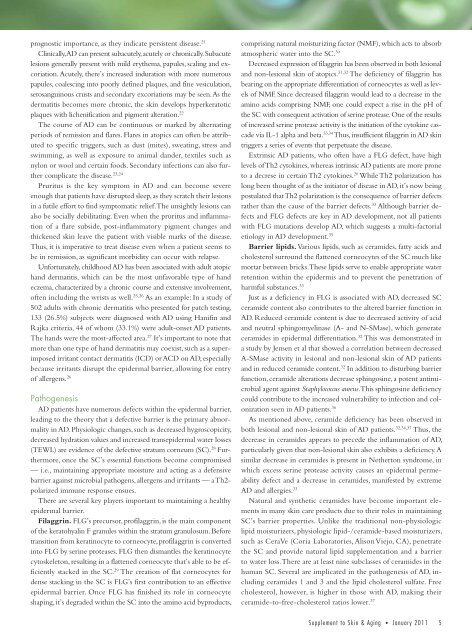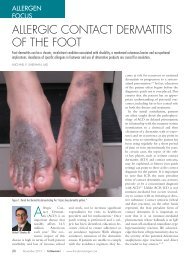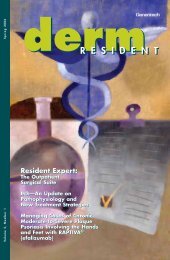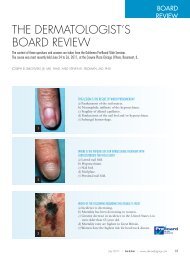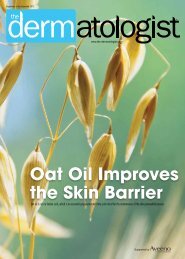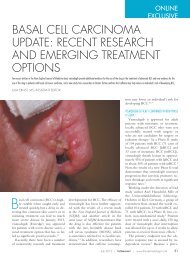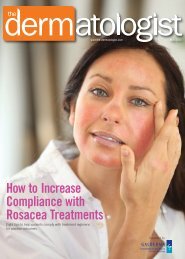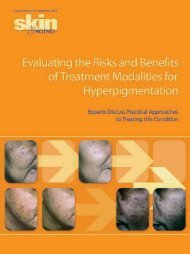TREATING ATOPIC DERMATITIS: - The Dermatologist
TREATING ATOPIC DERMATITIS: - The Dermatologist
TREATING ATOPIC DERMATITIS: - The Dermatologist
Create successful ePaper yourself
Turn your PDF publications into a flip-book with our unique Google optimized e-Paper software.
prognostic importance, as they indicate persistent disease. 21<br />
Clinically, AD can present subacutely, acutely or chronically. Subacute<br />
lesions generally present with mild erythema, papules, scaling and excoriation.<br />
Acutely, there’s increased induration with more numerous<br />
papules, coalescing into poorly defined plaques, and fine vesiculation,<br />
serosanguinous crusts and secondary excoriations may be seen. As the<br />
dermatitis becomes more chronic, the skin develops hyperkeratotic<br />
plaques with lichenification and pigment alteration. 22<br />
<strong>The</strong> course of AD can be continuous or marked by alternating<br />
periods of remission and flares. Flares in atopics can often be attributed<br />
to specific triggers, such as dust (mites), sweating, stress and<br />
swimming, as well as exposure to animal dander, textiles such as<br />
nylon or wool and certain foods. Secondary infections can also further<br />
complicate the disease. 23,24<br />
Pruritus is the key symptom in AD and can become severe<br />
enough that patients have disrupted sleep, as they scratch their lesions<br />
in a futile effort to find symptomatic relief. <strong>The</strong> unsightly lesions can<br />
also be socially debilitating. Even when the pruritus and inflammation<br />
of a flare subside, post-inflammatory pigment changes and<br />
thickened skin leave the patient with visible marks of the disease.<br />
Thus, it is imperative to treat disease even when a patient seems to<br />
be in remission, as significant morbidity can occur with relapse.<br />
Unfortunately, childhood AD has been associated with adult atopic<br />
hand dermatitis, which can be the most unfavorable type of hand<br />
eczema, characterized by a chronic course and extensive involvement,<br />
often including the wrists as well. 25,26 As an example: In a study of<br />
502 adults with chronic dermatitis who presented for patch testing,<br />
133 (26.5%) subjects were diagnosed with AD using Hanifin and<br />
Rajka criteria, 44 of whom (33.1%) were adult-onset AD patients.<br />
<strong>The</strong> hands were the most-affected area. 27 It’s important to note that<br />
more than one type of hand dermatitis may coexist, such as a superimposed<br />
irritant contact dermatitis (ICD) or ACD on AD, especially<br />
because irritants disrupt the epidermal barrier, allowing for entry<br />
of allergens. 26<br />
Pathogenesis<br />
AD patients have numerous defects within the epidermal barrier,<br />
leading to the theory that a defective barrier is the primary abnormality<br />
in AD. Physiologic changes, such as decreased hygroscopicity,<br />
decreased hydration values and increased transepidermal water losses<br />
(TEWL) are evidence of the defective stratum corneum (SC). 28 Furthermore,<br />
once the SC’s essential functions become compromised<br />
— i.e., maintaining appropriate moisture and acting as a defensive<br />
barrier against microbial pathogens, allergens and irritants — a Th2-<br />
polarized immune response ensues.<br />
<strong>The</strong>re are several key players important to maintaining a healthy<br />
epidermal barrier.<br />
Filaggrin. FLG’s precursor, profilaggrin, is the main component<br />
of the keratohyalin F granules within the stratum granulosum. Before<br />
transition from keratinocyte to corneocyte, profilaggrin is converted<br />
into FLG by serine proteases. FLG then dismantles the keratinocyte<br />
cytoskeleton, resulting in a flattened corneocyte that’s able to be efficiently<br />
stacked in the SC. 29 <strong>The</strong> creation of flat corneocytes for<br />
dense stacking in the SC is FLG’s first contribution to an effective<br />
epidermal barrier. Once FLG has finished its role in corneocyte<br />
shaping, it’s degraded within the SC into the amino acid byproducts,<br />
comprising natural moisturizing factor (NMF), which acts to absorb<br />
atmospheric water into the SC. 30<br />
Decreased expression of filaggrin has been observed in both lesional<br />
and non-lesional skin of atopics. 31,32 <strong>The</strong> deficiency of filaggrin has<br />
bearing on the appropriate differentiation of corneocytes as well as levels<br />
of NMF. Since decreased filaggrin would lead to a decrease in the<br />
amino acids comprising NMF, one could expect a rise in the pH of<br />
the SC with consequent activation of serine protease. One of the results<br />
of increased serine protease activity is the initiation of the cytokine cascade<br />
via IL-1 alpha and beta. 33,34 Thus, insufficient filaggrin in AD skin<br />
triggers a series of events that perpetuate the disease.<br />
Extrinsic AD patients, who often have a FLG defect, have high<br />
levels of Th2 cytokines, whereas intrinsic AD patients are more prone<br />
to a decrese in certain Th2 cytokines. 20 While Th2 polarization has<br />
long been thought of as the initiator of disease in AD, it’s now being<br />
postulated that Th2 polarization is the consequence of barrier defects<br />
rather than the cause of the barrier defects. 33 Although barrier defects<br />
and FLG defects are key in AD development, not all patients<br />
with FLG mutations develop AD, which suggests a multi-factorial<br />
etiology in AD development. 35<br />
Barrier lipids. Various lipids, such as ceramides, fatty acids and<br />
cholesterol surround the flattened corneocytes of the SC much like<br />
mortar between bricks. <strong>The</strong>se lipids serve to enable appropriate water<br />
retention within the epidermis and to prevent the penetration of<br />
harmful substances. 33<br />
Just as a deficiency in FLG is associated with AD, decreased SC<br />
ceramide content also contributes to the altered barrier function in<br />
AD. Reduced ceramide content is due to decreased activity of acid<br />
and neutral sphingomyelinase (A- and N-SMase), which generate<br />
ceramides in epidermal differentiation. 32 This was demonstrated in<br />
a study by Jensen et al that showed a correlation between decreased<br />
A-SMase activity in lesional and non-lesional skin of AD patients<br />
and in reduced ceramide content. 32 In addition to disturbing barrier<br />
function, ceramide alterations decrease sphingosine, a potent antimicrobial<br />
agent against Staphylococcus aureus. This sphingosine deficiency<br />
could contribute to the increased vulnerability to infection and colonization<br />
seen in AD patients. 36<br />
As mentioned above, ceramide deficiency has been observed in<br />
both lesional and non-lesional skin of AD patients. 32,34,37 Thus, the<br />
decrease in ceramides appears to precede the inflammation of AD,<br />
particularly given that non-lesional skin also exhibits a deficiency. A<br />
similar decrease in ceramides is present in Netherton syndrome, in<br />
which excess serine protease activity causes an epidermal permeability<br />
defect and a decrease in ceramides, manifested by extreme<br />
AD and allergies. 33<br />
Natural and synthetic ceramides have become important elements<br />
in many skin care products due to their roles in maintaining<br />
SC’s barrier properties. Unlike the traditional non-physiologic<br />
lipid moisturizers, physiologic lipid-/ceramide-based moisturizers,<br />
such as CeraVe (Coria Laboratories, Alison Viejo, CA), penetrate<br />
the SC and provide natural lipid supplementation and a barrier<br />
to water loss. <strong>The</strong>re are at least nine subclasses of ceramides in the<br />
human SC. Several are implicated in the pathogenesis of AD, including<br />
ceramides 1 and 3 and the lipid cholesterol sulfate. Free<br />
cholesterol, however, is higher in those with AD, making their<br />
ceramide-to-free-cholesterol ratios lower. 37<br />
Supplement to Skin & Aging ◆ Januar y 2011 5


